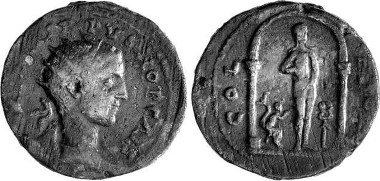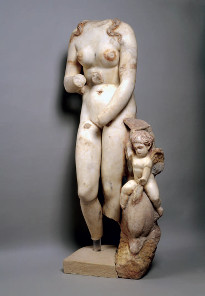by Yoav Farhi
A comparison between a statue of Aphrodite found at Beth Shean and a coin type from the mint of Ptolemais reminds us of the realistic nature of statues appearing on city coins and highlights the importance of these coins in reconstructing the urban landscape of Roman cities.
Coin of Ptolemais.
A coin type minted in Ptolemais (Akko) during the third century CE bears an image of Aphrodite on its reverse, with another figure next to her.
Aphrodite of Beth Shean, second century CE. Collection of the Israel Antiquities Authority. Photo: © The Israel Museum, Jerusalem, by Avraham Hay
The well-preserved marble statue of Aphrodite, found during the 1993 excavations at Beth Shean, sheds light on this coin type. The statue, uncovered in the eastern bath building, has been discussed in detail by G. Foerster. It is well preserved (except for its missing head and some parts of the hands and feet), with many traces of paint preserved. Along the goddess’s left leg runs a well-preserved support, in the form of a winged cupid riding a dolphin over waves.
This statue belongs to a well-known group of statues depicting Aphrodite entirely in the nude. Since these statues depict Aphrodite chastely covering her genitalia and breast with her hands, they have been referred to, since the nineteenth century as Venus Pudica, ‘Modest Venus (Aphrodite)’.
Hill described the coin type as: ‘Aphrodite of the Medici type, accompanied by Eros on a dolphin, in an arched shrine’. Neither M. Bernhart, nor later L. Kadman, identified precisely the building in which Aphrodite stood, describing her as standing under an arch. Kadman also argued that ‘… the flanking figures seem to be used as fountainheads’. Meshorer suggested that Aphrodite was standing in a bath or a niche, but identified the small figure as ‘Marsyas of the Forum’ and not as a cupid.
A well-preserved specimen from the Sofaer collection clearly depicts both the statue of Aphrodite and the image of a cupid on a dolphin. The obverse of the Sofaer coin presents a radiate and draped bust of Philip II to the right, accompanied by the inscription: [IVL] PHILIPPVS NOB CAES. The reverse presents a frontal view of a nude Aphrodite, standing under an arch; on her left, a cupid is depicted riding a dolphin and wielding a whip in his right hand; on her right, there is a winged caduceus (the city’s mint-mark). Another inscription appears in fields to the left and right of the arch; it reads: COL – PTOL (i.e., Colonia-Ptolemais).
Coin types presenting Aphrodite, of the Knidian and Medici types, are known from several cities in the eastern Mediterranean, especially in Asia Minor in the later second and early third centuries CE. Some coins depict Aphrodite within a distyle arch (in some cases accompanied by a dolphin but with no cupid); another coin presents her accompanied by a cupid riding a dolphin, but not within an arch. Most of these coins present her facing left or right, but not in full frontal view. Thus, to the best of my knowledge, the depiction on the coins of Ptolemais is unique to this city.
As aforementioned, a consideration of the statue from Beth Shean may shed new light on this type. In light of this statue, it seems clear that the figure of a cupid on a dolphin did not serve as a fountainhead, as suggested by Kadman (above), but as support for Aphrodite. The representation of a cupid riding a dolphin and wielding a whip, as he accompanies Aphrodite, was very common, as has been demonstrated by Foerster, and the combination of a cupid with a clearly maritime theme alludes to the story of Aphrodite’s origin in sea foam (Hesiod, Theogony, 188-199). Neither the cupid nor the dolphin are depicted on the coin in full view — as they appear with the statue. Instead, they are depicted in profile, obviously in order to show them clearly.
If one considers Foerster’s description of the statue while observing the coin, the resemblance becomes striking: ‘Aphrodite is portrayed in the nude, standing in the classical contrapposto position: her weight is placed on her left leg, her right leg is relaxed and bent slightly at the knee, and her body leans gently forward and to the left … with her right arm Aphrodite attempts, unsuccessfully, to “cover” her bare chest, while her left hand covers her genitalia…’.
As noted above, Hill assumed that Aphrodite was standing within an arched shrine, while Bernhart and Kadman noted only that she was standing under an arch. Meshorer was the first to suggest that Aphrodite was standing in a bath. Based on the statue from Beth Shean and its find-spot, it seems plausible that the arch under which Aphrodite stands represents either the local bathhouse or the niche within the bathhouse in which her statue was standing. In addition, the theme of Aphrodite accompanied by a cupid riding a dolphin is likely to be connected to bathing and water.
As noted by Kadman, representations of Aphrodite in the coinage of Phoenician and Palestinian cities are extremely rare. Moreover, as noted above, no representation like the one on the coins of Ptolemais is known from any other city coins in the region. Thus, the appearance of this type of coin, representing the statue of Aphrodite accompanied by a cupid, under several emperors at Ptolemais points to the importance and popularity of the specific bathhouse that is depicted on it. As suggested by Kadman and later Meshorer, this may be the same bathhouse that appears in the well-known tale of Rabban Gamliel, the second-century sage: Proklos, the son of Philosophos, approached Rabban Gamliel in Akko, while he was bathing in the Bath of Aphrodite, and said to him, ‘It is written in your Law, None of the devoted things shall cleave to your hand. Why then do you bathe in the bath of Aphrodite?’ He answered, ‘One may not answer in the bath’. And when he came out he said, ‘I came not within her limits, she came within mine! They do not say, “Let us make a bath for Aphrodite”, but “Let us make an Aphrodite as an adornment for the bath”. […]’.
The Aphrodite of Beth Shean has been identified as belonging to the Capitoline type, but as noted by Foerster himself, the hair- style, in which the braids fall in front of the shoulders (not behind them), is not identical to that of the Capitoline type. Moreover, despite Hill’s and Kadman’s identification of the Aphrodite on the coin as belonging to the Medici type, there the hair is entirely gathered and there are no braids at all.
It seems, therefore, that the Beth Shean statue and the coin type from Ptolemais, as well as another statue from Perge in Asia Minor, represent an eastern variant of the known Capitoline and Medici types, which differs from them in the hairstyle of the goddess. Foerster assumed that both the Aphrodite of Perge and the Aphrodite of Beth Shean were made in the same work-shop. One might tentatively suggest that the statue of Aphrodite from Ptolemais, depicted on the coin, originated there too.
The remarkable resemblance between the Beth Shean statue and the depiction on the coin type from Ptolemais not only contributes to our understanding of the coin type from Ptolemais but also reminds us of the realistic nature of statues appearing on city coins and of the importance of these coins in reconstructing the urban landscape of Roman cities.
This article appeared in Israel Exploration Journal 61, 2, 2011, 217-222 with references and a comprehensive bibliography.





